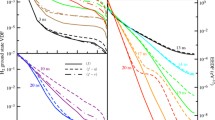Summary
Starting from former investigations of the field-free, collision-dominated temporal relaxation of the electron component in the postdiscarge regime for inert- and molecular-gas plasmas, we studied, in hydrogen, the effect of additional electron collisions with vibrationally excited behavhour. By numerically solving the appropriate electron Boltzmann equation, using the stationary distributions as initial states and suddenly switching off the electric field, the temporal behaviour of the energy distribution and the resulting mean energy and power transfer rates of the electrons were obtained for different physical conditions. Via the introduction of effective collision cross-sections and corresponding effective collision frequencies, the relaxation under different conditions can be analysed and interpreted. The relaxation between temporal evolutions and different types of collision processes have been found. Interesting findings are i) that electron collisions with vibrationally excited molecules, in particular second-kind collisions, are of minor importance in the first stage of relaxation, but become relevant only in the later phase; ii) that an increasing mixture of atoms leads to a sensitive change of the relaxation behaviour and to a marked increase of the corresponding relaxation time.
Riassunto
Il rilassamento della funzione di distribuzione dell'energia degli elettroni in plasmi di H2 è stato studiato nel regime di post-scarica introducendo l'effetto delle collisioni con molecole vibrazionalmente eccitate e con gli atomi d'idrogeno. I risultati sono stati ottenuti risolvendo l'appropriata equazione di Boltzmann, usando come stati iniziali le corrispondenti funzioni di distribuzione stazionarie e portando istantaneamente a zero il campo elettrico. L'evoluzione temporale della funzione di distribuzeone dell'energia degli elettroni, dell'energia media e delle velocità di trasferimento di energia è stata analizzata ed interpretata mediante l'uso di sezioni d'urto e frequenze di collisioni efficaci. I risultati mostrano i) che i processi collisionali coinvolgenti molecole vibrazionalmente eccitate (in particolare, collisioni del secondo tipo) influenzano poco il rilassamento iniziale della funzione di distribuzione avendo, al contrario un forte effetto nelle fasi successive; ii) che la presenza di atomi d'idrogeno cambia sensibilmente il rilassamento con forti aumenti dei tempi caratteristici.
Резюме
Учитывая эффекты соударений эпектронов с вибрационно возбужденными молекулами и атомами водорода, в режиме после разряда исследуется релаксация функции распределения эпектронов по энергиям в водородной плазме. Чисцленно решая соответствующее уравнение Больцмана для электронов, используя стацонарные распределения, как начальные состояния, и положив внезапно электрическое поле павным нулю, для различных физических условии поучаются временное поведение рацпределения энергии, средняя энерчия и средняя скоростя передачи энергии. Введение эффективных поперечных сечений соударений и соответствующих эффективных частот соудрений позволяет проанализировать и дать интерпретацию релаксации при различных условиях. Полученные результаты показывают, что 1) электронные соударения с вибрационно возбужденными молекулами (в частности, соударения второго типа) слабо влияют на релаксасацию функции распределения на первой стадии релаксции, но становятся существенными на последующих стадиях релаксации, что 2) наличие атомов водорода существенно меняет поведение релаксации и заметно увеличивает характерное время релаксации.
Similar content being viewed by others
References
J. Wilhelm andR. Winkler:Ann. Phys. (Leipzig) 34, 387 (1977).
R. Winkler andJ. Wilhelm:Beitr. Plasmaphys.,21, 163 (1981).
M. Capitelli, C. Gorse andA. Ricard:J. Phys. (Paris) Lett.,42, 469 (1981).
R. Winkler, P. Michel andJ. Wilhelm:Beitr. Plasmaphys.,18, 31 (1978).
J. Wilhelm andR. Winkler:J. Phys. (Paris),40, C7–251 (1979).
L. S. Frost andA. V. Phelps:Phys. Rev.,127, 1621 (1962).
H. Enrhardt, L. Langhans, F. Linder andH. S. Taylor:Phys. Rev.,173, 222 (1968).
M. Cacciatore andM. Capitelli:Chem. Phys.,55, 67 (1981).
M. Cacciatore, M. Capitelli andC. Gorse:J. Phys. D,13, 575 (1980).
M. Capitelli andM. Dilonardo:Z. Naturforsch. Teil A,34, 585 (1979).
W. L. Fite andR. T. Brackman:Phys. Rev.,112, 1141, 1151 (1958);W. Lichten andS. Schultz:Phys. Rev.,116, 1132 (1959).
W. L. Granowski:Der elekltrische Strom im Gas (Berlin, 1954).
D. K. Gibson:Austral. J. Phys.,23, 683 (1970).
R. H. Neynaber, L. L. Marino, E. W. Rothe andS. M. Trujillo:Phys. Rev.,124, 135 (1961).
A. G. Engelhardt andA. V. Phelps:Phys. Rev.,131, 2115 (1963).
Author information
Authors and Affiliations
Additional information
To speed up publication, the authors of this paper have agreed to not receive the proofs for correction.
Переведено редакцией.
Rights and permissions
About this article
Cite this article
Capitelli, M., Gorse, C., Wilhelm, J. et al. The influence of atoms and vibrationally excited molecules on the electron relaxation in the postdischarge regime of a weakly ionized hydrogen plasma. Il Nuovo Cimento B 70, 163–186 (1982). https://doi.org/10.1007/BF02814020
Received:
Revised:
Published:
Issue Date:
DOI: https://doi.org/10.1007/BF02814020




